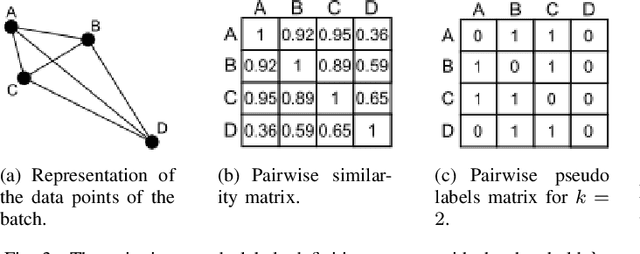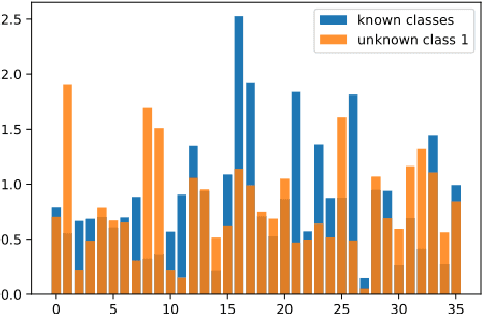Colin Troisemaine
Constructing Variables Using Classifiers as an Aid to Regression: An Empirical Assessment
Mar 13, 2024Abstract:This paper proposes a method for the automatic creation of variables (in the case of regression) that complement the information contained in the initial input vector. The method works as a pre-processing step in which the continuous values of the variable to be regressed are discretized into a set of intervals which are then used to define value thresholds. Then classifiers are trained to predict whether the value to be regressed is less than or equal to each of these thresholds. The different outputs of the classifiers are then concatenated in the form of an additional vector of variables that enriches the initial vector of the regression problem. The implemented system can thus be considered as a generic pre-processing tool. We tested the proposed enrichment method with 5 types of regressors and evaluated it in 33 regression datasets. Our experimental results confirm the interest of the approach.
A Practical Approach to Novel Class Discovery in Tabular Data
Nov 09, 2023Abstract:The problem of Novel Class Discovery (NCD) consists in extracting knowledge from a labeled set of known classes to accurately partition an unlabeled set of novel classes. While NCD has recently received a lot of attention from the community, it is often solved on computer vision problems and under unrealistic conditions. In particular, the number of novel classes is usually assumed to be known in advance, and their labels are sometimes used to tune hyperparameters. Methods that rely on these assumptions are not applicable in real-world scenarios. In this work, we focus on solving NCD in tabular data when no prior knowledge of the novel classes is available. To this end, we propose to tune the hyperparameters of NCD methods by adapting the $k$-fold cross-validation process and hiding some of the known classes in each fold. Since we have found that methods with too many hyperparameters are likely to overfit these hidden classes, we define a simple deep NCD model. This method is composed of only the essential elements necessary for the NCD problem and performs impressively well under realistic conditions. Furthermore, we find that the latent space of this method can be used to reliably estimate the number of novel classes. Additionally, we adapt two unsupervised clustering algorithms ($k$-means and Spectral Clustering) to leverage the knowledge of the known classes. Extensive experiments are conducted on 7 tabular datasets and demonstrate the effectiveness of the proposed method and hyperparameter tuning process, and show that the NCD problem can be solved without relying on knowledge from the novel classes.
An Interactive Interface for Novel Class Discovery in Tabular Data
Jun 22, 2023

Abstract:Novel Class Discovery (NCD) is the problem of trying to discover novel classes in an unlabeled set, given a labeled set of different but related classes. The majority of NCD methods proposed so far only deal with image data, despite tabular data being among the most widely used type of data in practical applications. To interpret the results of clustering or NCD algorithms, data scientists need to understand the domain- and application-specific attributes of tabular data. This task is difficult and can often only be performed by a domain expert. Therefore, this interface allows a domain expert to easily run state-of-the-art algorithms for NCD in tabular data. With minimal knowledge in data science, interpretable results can be generated.
Novel Class Discovery: an Introduction and Key Concepts
Feb 22, 2023Abstract:Novel Class Discovery (NCD) is a growing field where we are given during training a labeled set of known classes and an unlabeled set of different classes that must be discovered. In recent years, many methods have been proposed to address this problem, and the field has begun to mature. In this paper, we provide a comprehensive survey of the state-of-the-art NCD methods. We start by formally defining the NCD problem and introducing important notions. We then give an overview of the different families of approaches, organized by the way they transfer knowledge from the labeled set to the unlabeled set. We find that they either learn in two stages, by first extracting knowledge from the labeled data only and then applying it to the unlabeled data, or in one stage by conjointly learning on both sets. For each family, we describe their general principle and detail a few representative methods. Then, we briefly introduce some new related tasks inspired by the increasing number of NCD works. We also present some common tools and techniques used in NCD, such as pseudo labeling, self-supervised learning and contrastive learning. Finally, to help readers unfamiliar with the NCD problem differentiate it from other closely related domains, we summarize some of the closest areas of research and discuss their main differences.
Découvrir de nouvelles classes dans des données tabulaires
Nov 28, 2022Abstract:In Novel Class Discovery (NCD), the goal is to find new classes in an unlabeled set given a labeled set of known but different classes. While NCD has recently gained attention from the community, no framework has yet been proposed for heterogeneous tabular data, despite being a very common representation of data. In this paper, we propose TabularNCD, a new method for discovering novel classes in tabular data. We show a way to extract knowledge from already known classes to guide the discovery process of novel classes in the context of tabular data which contains heterogeneous variables. A part of this process is done by a new method for defining pseudo labels, and we follow recent findings in Multi-Task Learning to optimize a joint objective function. Our method demonstrates that NCD is not only applicable to images but also to heterogeneous tabular data.
A Method for Discovering Novel Classes in Tabular Data
Sep 02, 2022



Abstract:In Novel Class Discovery (NCD), the goal is to find new classes in an unlabeled set given a labeled set of known but different classes. While NCD has recently gained attention from the community, no framework has yet been proposed for heterogeneous tabular data, despite being a very common representation of data. In this paper, we propose TabularNCD, a new method for discovering novel classes in tabular data. We show a way to extract knowledge from already known classes to guide the discovery process of novel classes in the context of tabular data which contains heterogeneous variables. A part of this process is done by a new method for defining pseudo labels, and we follow recent findings in Multi-Task Learning to optimize a joint objective function. Our method demonstrates that NCD is not only applicable to images but also to heterogeneous tabular data. Extensive experiments are conducted to evaluate our method and demonstrate its effectiveness against 3 competitors on 7 diverse public classification datasets.
Construction de variables à l'aide de classifieurs comme aide à la régression
Dec 03, 2021



Abstract:This paper proposes a method for the automatic creation of variables (in the case of regression) that complement the information contained in the initial input vector. The method works as a pre-processing step in which the continuous values of the variable to be regressed are discretized into a set of intervals which are then used to define value thresholds. Then classifiers are trained to predict whether the value to be regressed is less than or equal to each of these thresholds. The different outputs of the classifiers are then concatenated in the form of an additional vector of variables that enriches the initial vector of the regression problem. The implemented system can thus be considered as a generic pre-processing tool. We tested the proposed enrichment method with 5 types of regressors and evaluated it in 33 regression datasets. Our experimental results confirm the interest of the approach.
 Add to Chrome
Add to Chrome Add to Firefox
Add to Firefox Add to Edge
Add to Edge